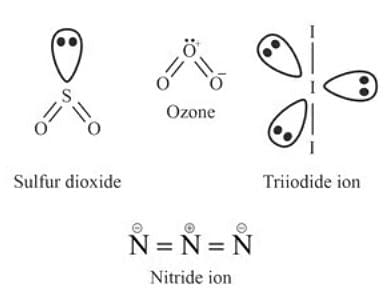The number of bent-shaped molecule(s) from the following is_______?
SO2, O3, I3-, N3-
SO2, O3, I3-, N3-
Solution and Explanation
1. SO2 (Sulfur Dioxide):
SO2 has a bent molecular geometry due to the lone pair of electrons on the sulfur atom, which causes electron pair repulsion and distorts the shape.
2. O3 (Ozone):
O3 has a central oxygen atom surrounded by one lone pair and three bonding electrons. This results in a bent molecular geometry, as the lone pair causes distortion in the structure.
3. I3- (Triiodide Ion):
I3- has a linear geometry. The central iodine atom has three lone pairs, and the bonding electrons are delocalized, maintaining a linear structure.
4. N3- (Azide Ion):
N3- is a linear molecule, as it consists of a chain of three nitrogen atoms connected by alternating double and single bonds, with delocalization of electrons across the structure.
Conclusion:
- Bent: SO2, O3
- Linear: I3-, N3-

So, Two molecules/ions, SO2 and O3, have a bent shape. The other two, I3- and N3-, have a linear form.
Top Questions on coordination compounds
Write two consequences of lanthanide contraction.
- CBSE CLASS XII - 2025
- Chemistry
- coordination compounds
Which is the correct IUPAC name for

- CBSE CLASS XII - 2025
- Chemistry
- coordination compounds
The steam volatile compounds among the following are:

- JEE Main - 2025
- Chemistry
- coordination compounds
- What is the color of the complex \([Ni(en)_3]^{2+}\) in water?
- KEAM - 2025
- Chemistry
- coordination compounds
- The formula of Ammonium phosphomolybdate is
- KEAM - 2025
- Chemistry
- coordination compounds
Questions Asked in JEE Main exam
If the system of equations \[ x + 2y - 3z = 2, \quad 2x + \lambda y + 5z = 5, \quad 14x + 3y + \mu z = 33 \] has infinitely many solutions, then \( \lambda + \mu \) is equal to:}
- JEE Main - 2025
- Calculus
- An electric dipole of mass \( m \), charge \( q \), and length \( l \) is placed in a uniform electric field \( E = E_0 \hat{i} \). When the dipole is rotated slightly from its equilibrium position and released, the time period of its oscillations will be:
- JEE Main - 2025
- Electric Dipole
The equilibrium constant for decomposition of $ H_2O $ (g) $ H_2O(g) \rightleftharpoons H_2(g) + \frac{1}{2} O_2(g) \quad (\Delta G^\circ = 92.34 \, \text{kJ mol}^{-1}) $ is $ 8.0 \times 10^{-3} $ at 2300 K and total pressure at equilibrium is 1 bar. Under this condition, the degree of dissociation ($ \alpha $) of water is _____ $\times 10^{-2}$ (nearest integer value). [Assume $ \alpha $ is negligible with respect to 1]
- JEE Main - 2025
- Law Of Chemical Equilibrium And Equilibrium Constant
- The distance of the point \( P(1, 2, 3) \) from the plane \( 3x - 4y + 12z - 7 = 0 \) is:
- JEE Main - 2025
- Geometry and Vectors
- Two iron solid discs of negligible thickness have radii \( R_1 \) and \( R_2 \) and moment of inertia \( I_1 \) and \( I_2 \), respectively. For \( R_2 = 2R_1 \), the ratio of \( I_1 \) and \( I_2 \) would be \( \frac{1}{x} \), where \( x \) is:
- JEE Main - 2025
- System of Particles & Rotational Motion
Concepts Used:
Coordination Compounds
A coordination compound holds a central metal atom or ion surrounded by various oppositely charged ions or neutral molecules. These molecules or ions are re-bonded to the metal atom or ion by a coordinate bond.
Coordination entity:
A coordination entity composes of a central metal atom or ion bonded to a fixed number of ions or molecules.
Ligands:
A molecule, ion, or group which is bonded to the metal atom or ion in a complex or coordination compound by a coordinate bond is commonly called a ligand. It may be either neutral, positively, or negatively charged.